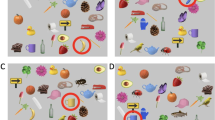Abstract
WHEN confronted with moving images, the visual system often must decide whether the motion signals arise from a single object or from multiple objects1–5. A special case of this problem arises when two independently moving gratings are superimposed. The gratings tend to cohere and move unambiguously in a single direction2 (pattern motion) instead of moving independently (component motion). Here we report that the tendency to see pattern motion depends very strongly on the luminance of the intersections (that is, to regions where the gratings overlap) relative to that of the gratings in a way that closely parallels the physics of transparency. When the luminance of these regions is chosen appropriately, pattern motion is destroyed and replaced by the appearance of two transparent gratings moving independently. The observations imply that motion detecting mechanisms in the visual system must have access to tacit 'knowledge' of the physics of transparency and that this knowledge can be used to segment the scene into different objects. The same knowledge could, in principle, be used to avoid confusing shadows with real object boundaries.
Similar content being viewed by others
References
Wallach, H. On Perception (Quadrangle, New York, 1976).
Adelson, E. H. & Movshon, J. A. Nature 300, 523–525 (1982).
Hildreth, E. C. The Measurement of Visual Motion (MIT, Cambridge, 1984).
Ramachandran, V. S. & Anstis, S. M. Scient Am. 254, 102–109 (1986).
Ramachandran, V. S. & Cavanagh, P. Vision Res. 27, 97–106 (1987).
Welch, L. Nature 337, 734–736 (1989).
Murphy, B. J., Kowler, E. & Steinman, R. M. Vision Res. 15, 1263–1268 (1975).
Beck, J. in Human and Machine Vision II (ed. Rosenfeld, A.) 1–12 (Academic, New York, 1986).
Metelli, F. Scient. Am. 230, 91–95 (1974).
Nakayama, K., Shimojo, S. & Ramachandran, V. S. Perception (in the press).
Crick, F. H. C. Nature 337, 129–132 (1989).
Ramachandran, V. S. in Vision: Coding and Efficiency (ed. Blakemore, C.) (Cambridge University Press, 1990).
Ramachandran, V. S. in Al and the Eye (ed. Blake, AS. & Troscianko, T.) (Wiley, Chichester, 1990).
Zeki, S. M. Proc. R. Soc. B 207, 239–248 (1980).
Allman, J., Miezin, F. & McGuinness, E. Perception 14, 105–126 (1985).
Van Essen, D. C. A. Res. Neurosci. 2, 227–263 (1979).
Movshon, J. A., Adelson, E. H., Gizzi, M. S. & Newsome, W. T. Study Group on Pattern Recognition Mechanisms (ed. Chagas, C., Gattass, R. & Gross, C. G.) (Vatican City, Pontifica Academia Scientiarum, 1984).
Albright, T. D. J. Neurophysiol. 52, 1106–1130 (1084).
Rodman, H. R. & Albright, T. D. Expl Brain Res. 75, 53–64 (1989).
Author information
Authors and Affiliations
Rights and permissions
About this article
Cite this article
Stoner, G., Albright, T. & Ramachandran, V. Transparency and coherence in human motion perception. Nature 344, 153–155 (1990). https://doi.org/10.1038/344153a0
Received:
Accepted:
Issue Date:
DOI: https://doi.org/10.1038/344153a0
- Springer Nature Limited
This article is cited by
-
Canonical circuit computations for computer vision
Biological Cybernetics (2023)
-
A neural correlate of perceptual segmentation in macaque middle temporal cortical area
Nature Communications (2022)
-
The role of transparency cues in afterimage color perception
Scientific Reports (2017)
-
Perceptual separation of transparent motion components: the interaction of motion, luminance and shape cues
Experimental Brain Research (2013)
-
Velocity computation in the primate visual system
Nature Reviews Neuroscience (2008)





